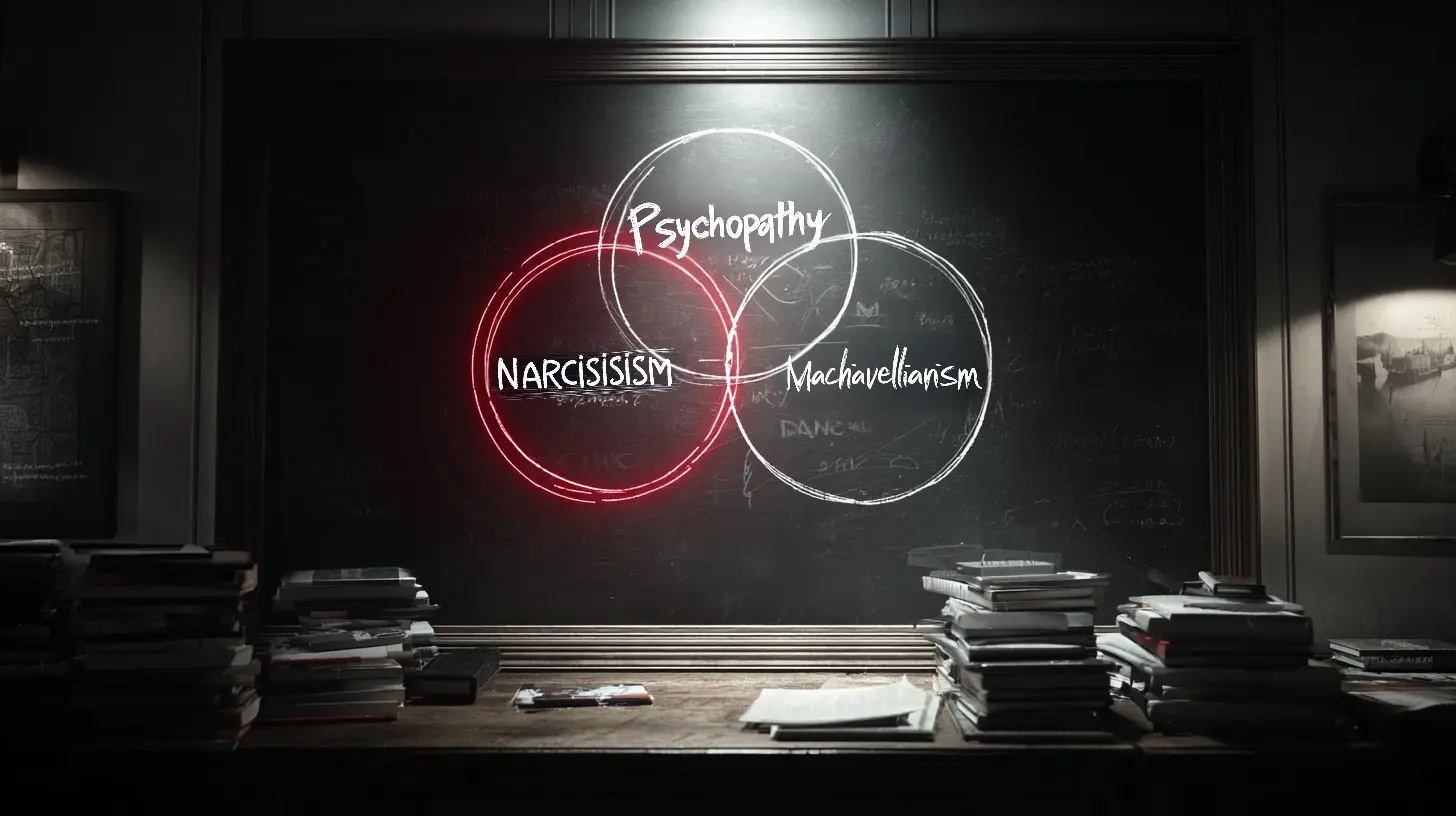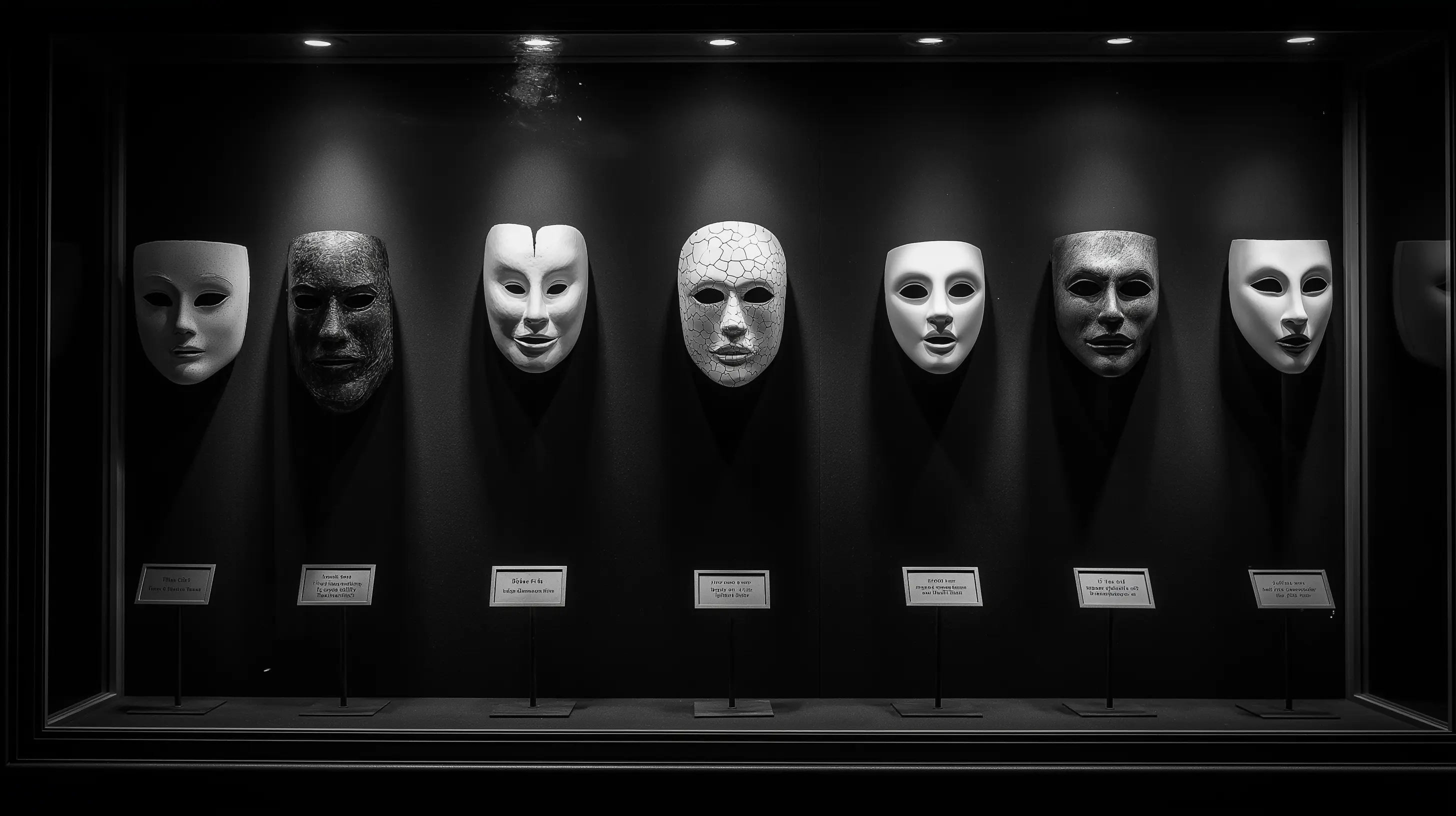What happens when personality becomes pathology?
When the traits that define us turn destructive? When the patterns that shape our behavior spiral into darkness?
The Dark Triad—narcissism, psychopathy, and Machiavellianism—represents the shadow side of human personality. These traits, when combined with the Enneagram’s nine personality types, create a disturbing but fascinating map of how normal personality patterns can evolve into pathological behavior.
From serial killers to corrupt politicians, from cult leaders to corporate psychopaths, we’ll explore how the Dark Triad manifests through each Enneagram lens. This isn’t about sensationalizing mental illness or glorifying violence—it’s about understanding the psychological patterns that can lead ordinary personality types down extraordinary dark paths.

Understanding the Dark Triad
Before we dive into specific cases, let’s define our terms:
The Dark Triad Components
Narcissism: Grandiose self-view, entitlement, dominance, and superiority. In clinical terms, this can escalate to Narcissistic Personality Disorder (NPD).
Psychopathy: Lack of empathy, remorse, and emotional depth. Characterized by impulsivity, thrill-seeking, and callous manipulation of others.
Machiavellianism: Strategic manipulation, cynical worldview, and moral flexibility. The belief that “the ends justify the means.”
These traits exist on a spectrum. We all have some degree of these characteristics—they become pathological when they dominate personality and harm others. (For a related exploration, see our guide on toxic traits of each Enneagram type.)
Important Disclaimer
This analysis is speculative and educational. We cannot definitively type individuals without direct assessment, especially those with severe mental illness. Mental health conditions exist across all Enneagram types, and having a particular type does not predispose someone to violence or criminality.
The goal here is to understand patterns, not to diagnose or stigmatize.
Type 1: When Perfectionism Becomes Pathological

Type 1s embody the principle of perfection, but when this drive becomes corrupted by the Dark Triad, it transforms into something terrifying: the belief that they alone know what’s “right” and must impose it on others at any cost.
The Righteous Executioner Pattern
Dark Triad Type 1s combine:
- Narcissism: Believing their standards are objectively correct
- Psychopathy: Coldly eliminating “imperfection”
- Machiavellianism: Manipulating systems to enforce their vision
Case Study: The Unabomber’s Crusade
Ted Kaczynski represents a potential Type 1 gone catastrophically wrong. His 35,000-word manifesto reveals classic Type 1 thinking twisted by isolation and mental illness:
- Rigid ideology about technology corrupting humanity
- Belief that violence was justified to achieve a “pure” society
- Meticulous planning and execution of attacks
- Complete certainty in his moral superiority
Kaczynski’s perfectionism merged with paranoid delusions, creating a deadly combination. He saw himself as humanity’s savior, justified in killing to prevent what he saw as greater harm.
The Corporate Perfectionist Tyrant
In less extreme cases, Dark Triad Type 1s might manifest as:
- Executives who destroy careers over minor infractions
- Judges who show no mercy, viewing themselves as moral arbiters
- Religious leaders who justify abuse as “purification”
The key pattern: Using perfectionism as a weapon, believing cruelty is righteousness.
Type 2: Love as Possession, Care as Control
Type 2s are the helpers, but when infected by Dark Triad traits, their need to be needed becomes a dangerous obsession. They don’t just want to help—they want to own.
The Intimate Predator Pattern
Dark Triad Type 2s exhibit:
- Narcissism: Believing they’re the only one who truly “understands” their target
- Psychopathy: Eliminating obstacles to their “love”
- Machiavellianism: Expertly manipulating emotions and dependencies
Case Study: Jodi Arias - When Love Kills
Jodi Arias murdered her ex-boyfriend Travis Alexander in 2008, stabbing him 27 times, slitting his throat, and shooting him. Her behavior patterns suggest a Type 2 corrupted by Dark Triad traits:
- Obsessive need to be central in Travis’s life
- Manipulation through sex and emotional dependency
- Stalking behaviors disguised as “caring”
- Narcissistic rage when rejected
- Creating elaborate lies about being the victim
Arias represents the Type 2’s shadow: love as possession, rejection as annihilation. She couldn’t bear not being needed, and when Travis tried to move on, she ensured no one else could have him.
The Caregiver Killer Phenomenon
Dark Triad Type 2s often appear in:
- Healthcare serial killers who “mercy kill” patients
- Stalkers who believe they’re “protecting” their victims
- Parents with Munchausen by proxy, making children sick for attention
The pattern: Weaponizing care, making others dependent, then controlling or destroying them.
Type 3: The Mask of Success Hiding Moral Bankruptcy
Type 3s chase achievement, but Dark Triad Type 3s will sacrifice anything—ethics, relationships, reality itself—for success. They don’t just want to win; they must win at any cost.
The Fraudulent Achiever Pattern
Dark Triad Type 3s combine:
- Narcissism: Grandiose self-image requiring constant validation
- Psychopathy: Complete lack of empathy for those they exploit
- Machiavellianism: Masterful deception and image management
Case Study: Richard Nixon’s Paranoid Presidency
Richard Nixon exemplifies the Type 3’s dark potential. Watergate revealed a man so obsessed with winning that he destroyed his presidency:
- Created an “enemies list” of those who threatened his image
- Secretly recorded everyone, paranoid about betrayal
- Orchestrated criminal acts while maintaining presidential facade
- Even with re-election secured, couldn’t stop the illegal surveillance
Psychobiographers note Nixon’s “grandiose self” battling a “degraded private self”—classic Type 3 splitting. His narcissism made him believe he was above the law; his Machiavellianism justified any means for political success.
Case Study: Elizabeth Holmes - The Billion Dollar Lie
Elizabeth Holmes of Theranos fame represents modern Type 3 pathology:
- Created elaborate fake demonstrations of blood testing technology
- Maintained “Steve Jobs” persona while knowing products didn’t work
- Manipulated investors, patients, and employees for years
- Showed no remorse for patients harmed by false medical results
Her narcissism convinced her she could “fake it till she made it” with human lives at stake.
The Success Psychopath in Business
Studies show psychopathic traits are overrepresented in CEOs. Dark Triad Type 3s thrive in corporate environments where:
- Results matter more than methods
- Image management is rewarded
- Empathy is seen as weakness
They climb ladders built on others’ backs, leaving destroyed careers in their wake.
Type 4: The Artist of Darkness

Type 4s feel deeply and differently, but Dark Triad Type 4s weaponize their uniqueness, using their pain to justify inflicting pain on others.
The Romantic Destroyer Pattern
Dark Triad Type 4s exhibit:
- Narcissism: Believing their suffering makes them special
- Psychopathy: Emotional volatility without empathy
- Machiavellianism: Using vulnerability as manipulation
The Tortured Artist Turned Predator
While many artists channel darkness creatively, some Type 4s with Dark Triad traits become destructive:
- Creating art from others’ suffering
- Justifying cruelty as “authentic expression”
- Manipulating through performed vulnerability
- Destroying those who don’t appreciate their “depth”
The Cult of Suffering
Dark Triad Type 4s often:
- Lead emotional manipulation cults
- Create trauma-bonded relationships
- Perform mental illness for attention
- Compete for who suffers most
They don’t just feel different—they weaponize that difference.
Type 5: The Detached Observer Becomes Cold Experimenter
Type 5s seek knowledge, but Dark Triad Type 5s treat humans as specimens, viewing suffering through a lens of scientific curiosity rather than empathy.
The Clinical Killer Pattern
Dark Triad Type 5s combine:
- Narcissism: Intellectual superiority complex
- Psychopathy: Complete emotional detachment
- Machiavellianism: Using knowledge to control
Case Study: Jeffrey Dahmer’s Grotesque Experiments
Jeffrey Dahmer potentially represents Type 5’s ultimate shadow. His crimes weren’t impulsive but methodical experiments:
- Attempted to create “zombies” through crude lobotomies
- Preserved body parts to study and possess
- Showed curiosity about death, not sadistic pleasure
- Described victims clinically, without emotion
Dahmer’s apartment became a laboratory of horror. He didn’t kill for thrill but for knowledge and control—the Type 5’s quest for understanding perverted into monstrous experiments.
The Intellectual Predator
Dark Triad Type 5s appear as:
- Scientists who experiment on humans without consent
- Hackers who destroy lives “to see if they can”
- Doctors who view patients as puzzles, not people
They’re not emotionally motivated—they’re curious about suffering.
Type 6: When Loyalty Becomes Paranoid Persecution
Type 6s seek security, but Dark Triad Type 6s create the very threats they fear, becoming paranoid tyrants who destroy perceived enemies.
The Paranoid Authority Pattern
Dark Triad Type 6s exhibit:
- Narcissism: Believing they alone see hidden threats
- Psychopathy: Preemptive strikes against “enemies”
- Machiavellianism: Creating surveillance states
Case Study: J. Edgar Hoover’s Reign of Fear
J. Edgar Hoover transformed the FBI into his personal weapon against perceived threats:
- Maintained secret files on thousands of Americans
- Blackmailed presidents and civil rights leaders
- Saw communists and subversives everywhere
- Created the very instability he claimed to prevent
Hoover represents Type 6’s counterphobic variant gone dark—attacking first to feel safe, creating enemies to justify paranoia.
Case Study: Jim Jones and Jonestown
Jim Jones potentially embodied Type 6’s cult leader variant:
- Created isolated community for “safety”
- Paranoid about government infiltration
- Loyalty tests escalating to mass suicide
- “Revolutionary suicide” as ultimate belonging
His fear of persecution became self-fulfilling prophecy.
The Security State Psychopath
Dark Triad Type 6s create:
- Surveillance systems that violate privacy
- Loyalty purges in organizations
- Witch hunts for invisible enemies
- Authoritarian “protection” that enslaves
They don’t feel safe until everyone is under control.
Type 7: The Hedonist’s Destructive Wake
Type 7s chase joy, but Dark Triad Type 7s consume everything in their path, leaving destruction while pursuing the next high.
The Manic Destroyer Pattern
Dark Triad Type 7s combine:
- Narcissism: Believing rules don’t apply to them
- Psychopathy: Impulsivity without consequence consideration
- Machiavellianism: Charming manipulation for resources
Case Study: The Wolf of Wall Street Era
While Jordan Belfort himself claims redemption, his story represents Type 7 excess:
- Massive fraud funding hedonistic lifestyle
- Drugs, sex, and material excess without limits
- Charming personality masking criminal enterprise
- No consideration for victims losing life savings
Dark Triad Type 7s in finance create:
- Ponzi schemes funding lavish lifestyles
- Pump-and-dump stocks for quick thrills
- Corporate cultures of toxic excess
The Addiction Vampire
Dark Triad Type 7s often:
- Deal drugs while using, spreading addiction
- Create party cultures that destroy lives
- Use and discard people for entertainment
- Leave financial and emotional wreckage
They’re not just escaping pain—they’re spreading it.
Type 8: Power Corrupted into Domination
Type 8s embody strength, but Dark Triad Type 8s transform power into domination, control into cruelty, strength into sadism.
The Apex Predator Pattern
Dark Triad Type 8s exhibit:
- Narcissism: Believing might makes right
- Psychopathy: Violence without hesitation
- Machiavellianism: Strategic domination
Case Study: Ted Bundy - The Charming Predator
Ted Bundy potentially represents Type 8’s darkest expression:
- Charm concealing absolute need for control
- Selecting victims he could overpower
- No empathy, only domination drive
- Escaped custody twice, refusing capture
Bundy wasn’t driven by sexual deviance primarily but by power—the ultimate control over life and death.
Case Study: Harvey Weinstein’s Empire of Abuse
Harvey Weinstein built a system of predation:
- Used professional power for sexual domination
- Created network of enablers and silencers
- Destroyed careers of those who resisted
- Showed rage when challenged
His empire was built on fear—classic Type 8 shadow.
The Systemic Abuser
Dark Triad Type 8s create:
- Cultures of intimidation and fear
- Networks protecting their predation
- Systems where only strength survives
- Hierarchies based on domination
They don’t just seek power—they feed on others’ powerlessness.
Type 9: The Void That Swallows
Type 9s seek peace, but Dark Triad Type 9s create peace through annihilation, merger through consumption, harmony through homicide.
The Dissociative Destroyer Pattern
Dark Triad Type 9s combine:
- Narcissism: Believing their peace matters most
- Psychopathy: Emotional numbness enabling violence
- Machiavellianism: Passive-aggressive destruction
Case Study: The Quiet Killer Phenomenon
Many serial killers described as “quiet” or “wouldn’t hurt a fly” may represent Type 9’s shadow:
- Dennis Rader (BTK) - Church president and scout leader
- Gary Ridgway (Green River) - Described as mild-mannered
- Robert Hansen - Quiet baker who hunted humans
These killers maintained peaceful facades while committing atrocities, dissociating completely from their crimes.
The Passive Annihilator
Dark Triad Type 9s might:
- Enable abuse through willful blindness
- Destroy through neglect and abandonment
- Eliminate sources of conflict permanently
- Create peace through others’ silence
They don’t actively destroy—they allow destruction through inaction, or eliminate disruption to their peace.
Understanding the Patterns
Common Threads Across Types
Regardless of Enneagram type, Dark Triad manifestations share:
- Justification narratives: Each type has a story explaining why their actions are necessary
- Target selection: Victims often represent what the type most fears or desires
- Escalation patterns: Starting with minor violations, building to major crimes
- Cognitive distortions: Reality bent to support their worldview
The Role of Trauma and Mental Illness
It’s crucial to understand that:
- Dark Triad traits often emerge from severe trauma (explore Enneagram trauma responses)
- Mental illness can distort any personality type (see the Enneagram and mental illness)
- These patterns represent extremes, not inevitabilities
- Most people with these conditions never become violent
Warning Signs Across Types
Understanding how each type behaves under stress can help identify these warning signs early:
- Type 1: Increasing rigidity and punishment
- Type 2: Possessive behavior and boundary violations
- Type 3: Escalating deception and image management
- Type 4: Performative suffering and emotional manipulation
- Type 5: Dehumanization and viewing people as objects
- Type 6: Paranoid accusations and preemptive attacks
- Type 7: Reckless consumption without regard for others
- Type 8: Escalating domination and control
- Type 9: Increasing dissociation and passive destruction
The Purpose of Understanding Darkness
Why examine these dark patterns? Not for sensationalism, but for:
Prevention and Intervention
Understanding how personality types can spiral helps:
- Identify warning signs early
- Develop targeted interventions
- Create support systems before crisis
- Address root causes, not just symptoms
Compassion Through Understanding
Recognizing that even monsters were once human helps us:
- Address societal factors creating these conditions
- Develop empathy without excusing behavior
- Understand victims’ experiences more deeply
- Prevent demonization of mental illness
Personal Shadow Work
Examining extreme cases helps us recognize our own shadows. For guidance on integrating these shadow aspects, see our shadow work by Enneagram type guide:
- Type 1s can see their judgmental tendencies
- Type 2s can recognize possessive impulses
- Type 3s can acknowledge deceptive patterns
- And so on for each type
Integration and Healing
The Opposite of Dark Triad
Each type also has potential for extraordinary good:
- Type 1: Principled reform and justice
- Type 2: Genuine compassion and service
- Type 3: Inspiring achievement and excellence
- Type 4: Transformative creativity and depth
- Type 5: Breakthrough insights and innovation
- Type 6: Courageous loyalty and protection
- Type 7: Infectious joy and possibility
- Type 8: Protective strength and leadership
- Type 9: Healing presence and mediation
The Path Forward
Understanding darkness isn’t about fear but awareness. By recognizing these patterns, we can:
- Develop healthier expressions of our type’s drives
- Seek help when we recognize concerning patterns
- Support others showing warning signs
- Build systems that prevent rather than enable
- Transform shadow into conscious growth
Conclusion: Light from Darkness
The Dark Triad meets the Enneagram not to glorify evil but to understand it. Each personality type contains seeds of both transcendence and destruction. The difference lies not in our type but in our choices, our support systems, our self-awareness, and our commitment to growth.
These extreme cases serve as warnings and teachers. They show us what happens when personality becomes pathology, when traits become tyranny, when the shadow consumes the light.
But they also remind us that understanding darkness is the first step toward choosing light. Every type has the capacity for both great harm and great healing. The question isn’t what type we are, but what we do with that knowledge.
In examining the worst expressions of each type, we better understand how to cultivate the best. The Dark Triad may reveal our shadows, but the Enneagram shows us the path toward integration, healing, and wholeness. For the constructive path forward, explore how each type manipulates (and how to spot it) or begin your Enneagram self-development journey.
Remember: If you recognize concerning patterns in yourself or others, seek professional help. Mental health support can prevent trajectories toward darkness and guide toward healing.
